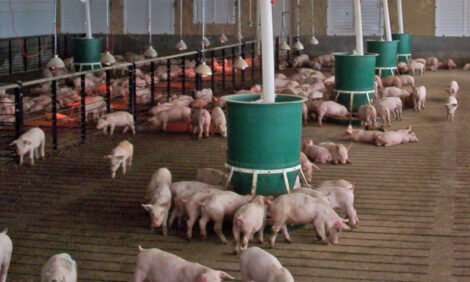



Ventilation and Heating Costs - Weather in the last month
By Nick Bird for FarmEx - Running costs of heating and ventilation systems depend on the weather. In warmer weather, more ventilation is needed to remove pig heat. In colder weather, more heating is needed. When considering heating running costs, you obviously have to take account of ambient temperature.The answer is yes. Yes it's been hotter, but yes it's been colder. (Data from reference site in Suffolk 19th Nov - 19th December 2002 / 2003.)
| 2002 | 2003 | |
| Mean Temperature | 5.90ºC | 6.17ºC |
| Standard Deviation | 2.85ºC | 3.40ºC |
| Min / Max | -1.3 / 12.3ºC | -3.0 / 14.3ºC |
| Mean Daily Range | 3.81ºC | 5.22ºC |
| Std of Mn Daily Range | 1.54ºC | 2.45ºC |
The warmest temperatures are slightly higher than last year, and the lowest slightly lower, but the average is only slightly different. However, the general perception is that it has been marginally colder.
The biggest difference between this year and last are the temperature swings. The mean daily range (max-min in any 24 hour period) has been larger and more variable. Last year, the daily range of temperature was typically 3 to 5ºC, and the highest daily range is only 7.5ºC. This year it has typically been typically 7 or 8, and the highest is 12.6ºC.
This is a serious challenge to the "ability to cope" for humans, pigs and ventilation systems alike. You can see this quite clearly with humans going to work - one day you'll see them skimpily clad - even though it's freezing - because there has been a run of warm days. Another they are sweltering under a heavy raincoat in blazing sunshine.
A manually regulated ventilation system hasn't much of a hope of achieving any particular temperature under these circumstances. Conceivably, if producers paid very strict attention to the weather forecasts and diligently acted on the (usually fairly accurate) projections for the next few hours, they might have some sort of chance. However, one tends to find that producers opting for the ultra-low capital input implied by lack of automatic regulation are not typically inclined to "undo all their good work" by then using the high labour input necessary for frequent manual adjustment.
Varying outside temperatures are a challenge for automatic regulation systems, but the more so because users very often use them in a "semi-manual" manner. That is they "improve" system performance by adjusting settings such as target temperature and minimum ventilation rate on the basis of skill, experience, "air quality" and factors such as how the pigs are lying.
Whether or not they are right in the perceived need to make such adjustments - or in the degree of adjustments they make - such varying temperatures puts it under severe strain. One day it's mild, the next it may be mild, or freezing. What has happened today or yesterday has been - this last month - no particular guide to what will happen tonight or tomorrow.
Weather is usually "cyclic" with a period of 5 to 10 days. For example, temperatures gradually rise for a few days, then fall for a few days - with a daily range imposed on top of that. If temperature fell, say, to 3ºC last night, they are likely to be similar tonight - falling to between 1 and 5ºC, say. Although that has happened this year, there have also been significant deviations from the pattern.



Discussion
We are all aware that - in the past few years - investment in pig buildings has been especially
low.
Given a run of a few years when winters have not been particularly severe, it may well be that
factors such as poor insulation and worn out controls has not had such a severe impact on
production as may have been expected. To put it another way - producers may have been
lulled into a false sense of security.
It's not suggested that the weather in the past month is any evidence of the effects of global
warming. However, it's worth mentioning that one of the advised effects of global warming is
an increase in the variability of weather. The slightly different weather this year to last
illustrates the type of thing which is to come (though in a small way).
The net result of the more variable conditions is that one would reasonably expect pig
performance to be marginally worsened this year as compared to last, even leaving aside the
probable further worsening in the housing stock.
More extreme weather will also be expected to have an effect on running cost. The following
table summarises the output of a dynamic model of running costs of a well-insulated 120
place flat deck (averaged) holding pigs at 10kg, with 4kw heating capacity. Costs - and impact
of changing climate - are also significantly affected by how the building is operated.
| 2002 | 2003 | |
| Electrical costs with 10% min vent setting @27ºC | £47.20 | £45.52 |
| Increase/Decrease | -3.6% | |
| (Average ventilation achieved) | 10% | 10% |
| Electrical costs with 5% min vent setting | £5.62 | £5.94 |
| Increase/Decrease | +5.7% | |
| (Average ventilation achieved) | 5.6% | 5.8% |
This table compares (thermodynamically modelled) electrical energy use (converted at 5 pence per unit).
With a typical user setting of 10% minimum ventilation, slightly less energy would be used (3.6% reduction). This is mostly because of the slightly higher average temperature, but the reduction is greater than the change in average temperature would suggest. In 2002, the average temperature was 5.9ºC, requiring an average temperature lift of 21.1ºC, as compared to 6.17 and 20.83ºC. The change in temperature lift is only 1.3%, but reduction in energy is 3.6%.
However, if minimum ventilation rate is set to 5% (which is all that the models suggest is actually needed), then the building is in heat surplus for some of the time, and uses far less energy - in either case, the reduction in energy use (as compared to a minimum of 10%) is almost 90%. However, note that the energy use is slightly higher in 2003 - an increase of 5.7% (due to greater fan use) - rather than lower, as compared to 2002.
It's worth noting that the levels of difference are comparable with or greater than the changes required for compliance with Climate Change Levy Discount Agreements (CCAs) per milestone. It suggests that compliance or non-compliance with milestone targets could be affected by minor year on year differences in weather, even though the mean temperatures suggest the effect should be very small.
Source: FarmEx - December 2003








